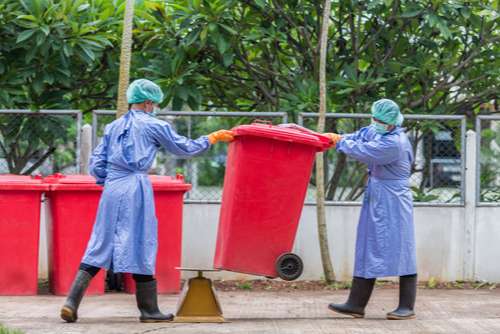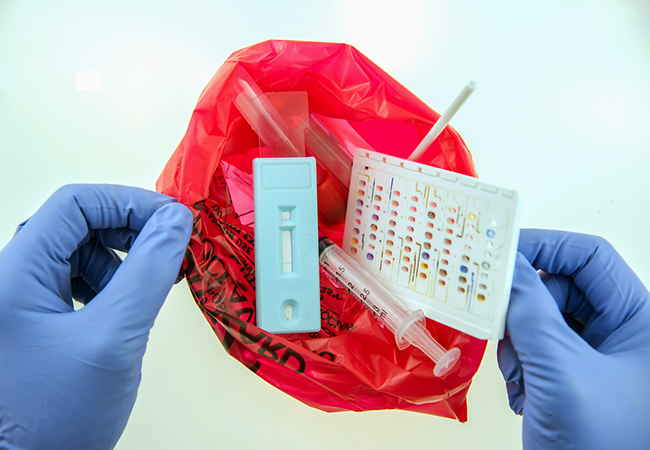Guardians of Tidiness: Local Medical Waste Removal Service for Your Comfort
Guardians of Tidiness: Local Medical Waste Removal Service for Your Comfort
Blog Article
The Importance of Appropriate Clinical Garbage Disposal: A Guide for Healthcare Facilities
Correct clinical waste disposal is an important element of health care center administration, guaranteeing the safety and security and wellness of clients, staff, and the environment. From recognizing the various classifications of clinical waste to abiding by regulative requirements, health care centers should take on efficient waste segregation techniques and select appropriate disposal approaches. Nevertheless, the significance of proper clinical waste disposal goes past mere conformity; it is an obligation that calls for continuous training and education for personnel. In this overview, we will certainly check out the numerous aspects of clinical garbage disposal and highlight the important actions that medical care facilities must take. By implementing these methods, medical care facilities can minimize risks, safeguard public wellness, and add to a cleaner, safer environment.
Understanding Medical Waste Categories
Comprehending medical waste groups is important for appropriate disposal in medical care centers. Medical waste is a broad term that incorporates various sorts of waste created in medical care setups, such as medical facilities, labs, and centers. Classifying medical waste aids guarantee that it is taken care of, kept, and disposed of securely and according to appropriate regulations.
There are several categories of clinical waste that healthcare facilities need to be mindful of. These groups consist of contagious waste, sharps waste, pharmaceutical waste, chemical waste, and radioactive waste (medical waste disposal services with WasteX). Each classification has particular features and calls for various disposal methods to lessen the threat of injury to health care employees, patients, and the environment
Transmittable waste, as an example, refers to lose infected with potentially infectious materials, such as blood, body fluids, and cells. Sharps waste includes needles, syringes, and other sharp things that can cause injury or transmit infections. Pharmaceutical waste consists of run out or unused drugs, while chemical waste contains dangerous chemicals used in medical procedures. Lastly, radioactive waste includes materials contaminated with radioactive materials, such as nuclear medication materials.
Compliance With Regulatory Needs
Healthcare facilities should make sure conformity with regulatory needs for correct clinical garbage disposal. Regulative bodies, such as the Epa (EPA) and the Occupational Safety and Health Administration (OSHA), have actually established guidelines and regulations to secure public health and the setting. These regulations outline the proper handling, storage space, transport, and disposal of clinical waste.
Compliance with governing demands is important for healthcare centers to prevent legal charges, reputational damages, and prospective injury to human health and the atmosphere. Failing to follow these guidelines can cause penalties, suits, and even the suspension or cancellation of running licenses.
To guarantee compliance, healthcare facilities must establish thorough waste administration programs that include personnel training, appropriate waste segregation, and making use of suitable containers and tags. Routine audits and evaluations need to also be performed to determine any kind of non-compliance issues and address them promptly.
It is crucial for healthcare centers to keep up to date with modifications in laws and upgrade their waste monitoring methods as necessary. This can be achieved by actively monitoring updates from regulative bodies and joining training programs and workshops.
Executing Reliable Waste Partition Practices
To ensure correct medical garbage disposal, healthcare centers must execute efficient waste partition techniques. Waste segregation is a vital action in the overall waste administration procedure, as it aids lessen the risk of infection, stops cross-contamination, and makes certain the risk-free disposal of various sorts of waste. Efficient waste partition methods include dividing medical waste right into various groups based upon its characteristics and possible threats.
One common method is the partition of sharps waste, such as scalpels and needles, from other sorts of medical waste. Sharps waste ought to be positioned in puncture-resistant containers to stop injuries and possible infections. Furthermore, contaminated materials, such as chemicals and drugs, must be separated from general clinical waste to avoid environmental contamination.
Proper labeling and color-coding of waste containers are vital for effective waste segregation. Visible and clear tags need to be positioned on each container to suggest the kind of waste it contains and any special delivery needs - medical waste disposal services with WasteX. In addition, color-coding can be used to set apart between various waste categories, making it easier for medical care team to get rid of and identify of waste correctly
Routine training and education and learning for healthcare team is important for the effective implementation of waste partition practices. Personnel need to be informed medical waste disposal services with WasteX on the various waste categories, appropriate partition strategies, and the relevance of adhering to waste management methods. This will assist make sure compliance and consistency in waste partition practices throughout the facility.
Deciding On Appropriate Disposal Techniques
Appropriate option of suitable disposal methods is important in guaranteeing the risk-free and environmentally liable monitoring of clinical waste in medical care centers. Health care facilities produce a range of clinical waste, including sharps, infectious waste, pharmaceutical waste, and chemical waste - medical waste removal. Each sort of waste calls for certain disposal methods to minimize the danger of contamination, injury, and environmental harm
One common disposal technique for medical waste is incineration. Incineration includes the regulated burning of waste at high temperature levels. This approach works in destroying pathogens and decreasing the quantity of waste. It can launch harmful contaminants into the air if click not effectively regulated.

Chemical disinfection is an additional technique used for sure kinds of clinical waste, such as pharmaceutical waste. This technique uses chemicals to reduce the effects of or damage pollutants. It is essential to pick chemicals that are eco friendly and safe.
Sometimes, land fill disposal may be suitable for non-hazardous clinical waste (medical waste disposal services with WasteX). Nonetheless, proper partition and product packaging are crucial to stop leakage or contamination.
Ultimately, health care centers must very carefully review the features of their medical waste and select suitable disposal methods that focus on safety and security, environmental management, and governing conformity. Routine training and tracking are necessary to make sure that health care team follows proper disposal methods.

Training and Educating Team on Appropriate Disposal Procedures
Staff education and learning and training play an important duty in making sure the correct disposal of clinical waste in healthcare centers. It is necessary that all personnel, including physicians, nurses, professionals, and support team, obtain extensive training on correct disposal procedures. This training needs to cover the various kinds of clinical waste, their potential dangers, and the suitable methods for managing, setting apart, and dealing with them.
Among the primary goals of team education and training is to guarantee that all healthcare specialists comprehend the significance of correct disposal procedures and the possible consequences of inappropriate waste administration. They require to be familiar with the threats connected with medical waste, such as the transmission of infections and the contamination of the atmosphere. medical waste removal near me. By comprehending these threats, employee will be extra motivated to follow correct disposal protocols and take the essential precautions to safeguard themselves, their associates, and the area
Educating must additionally cover the usage of individual protective equipment (PPE) and the appropriate techniques for handling medical waste. Personnel members should be educated on how to identify and segregate various types of waste, such as sharps, contagious waste, and unsafe chemicals. They should more helpful hints additionally be educated on the correct use waste containers, such as sharps containers and biohazard bags, in addition to the importance of labeling and sealing these containers correctly.
Moreover, team education and training ought to consist of normal updates and refresher course programs to make sure that health care experts stay informed concerning the most up to date policies and ideal techniques in clinical waste disposal. This ongoing education is important to maintain a high level of awareness and compliance among employee.
Final Thought
In final thought, proper medical waste disposal is of utmost importance for health care facilities. Recognizing the different classifications of clinical waste and complying with governing requirements guarantees the security and health of both healthcare workers and the general public.
From recognizing the different groups of clinical waste to conforming with regulatory demands, healthcare facilities need to adopt reliable waste partition practices and pick proper disposal methods. These classifications consist of infectious waste, sharps waste, pharmaceutical waste, chemical waste, and contaminated waste.To ensure appropriate clinical waste disposal, health care facilities should apply effective waste partition techniques. Waste partition is a vital action in the overall waste administration procedure, as it aids minimize the danger of infection, prevents cross-contamination, and makes sure the secure disposal of various types of waste. Medical care centers generate a variety of clinical waste, consisting of sharps, infectious waste, pharmaceutical waste, and chemical waste.
Report this page